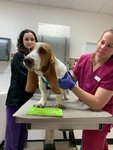Looking after pets as Texas heat indexes remain high
With temperatures and humidity rising in Katy this summer, it is important for residents to take caution; not only with themselves but with their pets. When exposed to temperatures above 101 degrees, …
This item is available in full to subscribers.
Attention subscribers
To continue reading, you will need to either log in to your subscriber account, or purchase a new subscription.
If you are a current print subscriber, you can set up a free website account and connect your subscription to it by clicking here.
If you are a digital subscriber with an active, online-only subscription then you already have an account here. Just reset your password if you've not yet logged in to your account on this new site.
Otherwise, click here to view your options for subscribing.
Please log in to continue |
Looking after pets as Texas heat indexes remain high
With temperatures and humidity rising in Katy this summer, it is important for residents to take caution; not only with themselves but with their pets. When exposed to temperatures above 101 degrees, small animals like dogs and bigger animals such as horses are at risk for heat injuries.
“It certainly is a real concern that can have potentially fatal outcomes,” said Kari Cleavinger, Doctor of Veterinary Medicine in the Katy Veterinary Clinic. “If it's not addressed in a timely fashion and if the heat stroke is too severe, sometimes even with treatment, pets don't make it.
Treatment for Smaller Animals
The two main concerns that arise when small animals like dogs are exposed to extreme temperatures are heat burns on the paws and heat stroke. If the pavement is too hot for us to walk with our bare feet then it is probably too hot for dogs’ paws, Cleavinger said.
“We can see some, you know, some pretty intense burns of the pads of the feet when dogs are walking on the hot pavement during the summer. That's something that I think owners don't think about too often because we always wear shoes so we're not feeling how hot the pavement is,” said Cleavinger.
While burns on the paws are harmful, heat stroke is deadly, Cleavinger said. That’s why owners should watch out for specific symptoms in hot temperatures. Things such as heavy breathing and collapse are all symptoms that could potentially mean an animal has heat stroke.
“The first symptom that dog owners will see at home is usually collapse. Dogs will collapse (or) they’re breathing heavily, potentially having some problems with heartbeat. They're dehydrated, that's hard for the owner to discern. But usually collapse is the first sign that an owner will see at home,” Cleavinger said.
Owners can take action before or in the event these symptoms are recognized though. Walking dogs in the early morning or late afternoon, leaving options for shade, and removing dogs from hot cars are all things owners can do to prevent heat stroke, said Cleavinger. If a pet does collapse, owners should take them to a clinic immediately, placing damp towels on the pet and using air conditioner generously.
“We always want to use damp, cool towels to place on the pet. When you're in the car either put the air conditioning on them or roll down the windows -- some kind of air movement to move across those damp towels. You never want to use ice. Ice constricts the blood vessels and limits the heat dissipation from the skin so it can actually complicate matters,” Cleavinger said.
Owners should go to a clinic whenever they feel concerned, said Cleavinger, since most damage from heat stroke can go unnoticed for up to 24 hours.
“But I would say if there's ever any concern that the pet owner has in their mind, they do need to seek medical therapy or medical treatments. (We just need to let our) owners know that this is a true concern,” Cleavinger said.
Treatment for Larger Animals
The effect on larger animals such as horses are much the same, said Katy Equine Clinic veterinarian, Bill Stone, but has its exceptions.
“Horses have a particular problem in this in this part of the country,” Stone said. “They'll occasionally stop sweating. And that's a challenge for them. Dogs don't sweat, but horses will sometimes stop sweating and their body mass can't be cool.”
That’s why owners should keep watch for increased breathing, increased body temperature, and lack of sweat, said Stone. These could be indicators of overheating and could potentially be fatal if it leads to collapse.
“(Collapse) doesn’t happen often but if it does happen, they’re real close to being in trouble. It’s a huge emergency with a body mass as big as a horse,” Stone said.
Luckily, treatment for overheating is simple and doesn’t usually require a vet, said Stone. With things like mist fans, mixtures of alcohol and water, or even breaks from working, owners can effectively decrease the horse’s body temperature.
“Our body (and) horses’ bodies are cooled by evaporation. So, anything you can do to enhance evaporative cooling is going to help. Large volumes of water are great -- they're going to cool you down to a certain extent -- but the water has to evaporate for that,” Stone said.
It all comes down to evaporation and ventilation, Stone added. Owners just have to pay attention and keep their horses comfortable.
Keywords
Katy Veterinary Clinic, Kari Cleavinger, Dogs, Cats, Horses, pet, pets, Owners, Kety Equine Clinic, Bill Stone, overheating











